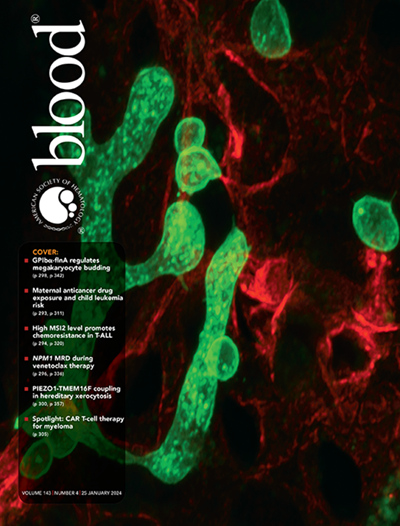白细胞介素-33受体(ST2)是一种新的治疗靶点,以减轻血友病关节病的进展。
IF 21
1区 医学
Q1 HEMATOLOGY
引用次数: 0
摘要
A型血友病是一种由凝血蛋白因子VIII缺乏引起的x连锁出血性疾病。血友病患者会出现反复出血。当关节发生出血时,可能会发生血友病性关节病(HA),导致关节出血和关节变形。利用CRISPR/Cas9靶向F8基因外显子-1 (F8em1-/-)构建一种新型的先天性小鼠血友病A模型,探讨HA期间出血和炎症的变化。F8em1-/-小鼠自发性出血的外显率很高,关节出血进展为关节病。F8em1-/-小鼠接受针性膝关节损伤以评估同步关节出血,并评估HA和滑膜炎症的发展情况。F8em1-/-小鼠损伤关节滑膜损伤后炎性基因的差异表达和时间表达。通路分析发现,针刺诱导HA后,小鼠滑膜中IL-1家族细胞因子IL-1b和IL-33以及各自的受体IL-1RAP和T1/ST2 (ST2)上调。针刺关节损伤后急性期F8em1-/-小鼠血浆可溶性ST2和IL-33水平升高。产生双ST2缺陷的F8em1-/-小鼠,相对于F8em1-/-小鼠,ST2缺陷的血友病小鼠在针伤后的关节损伤明显减少。通过治疗性干预,在血友病小鼠HA期间,阻断关节损伤后的ST2显著改善了关节损伤。这些研究在一种新的HA小鼠模型中确定了ST2在HA发病机制中的关键作用,并强调了其作为一种新的治疗靶点的潜力。本文章由计算机程序翻译,如有差异,请以英文原文为准。
The interleukin-33 receptor (ST2) is a novel therapeutic target to attenuate the progression of hemophilic arthropathy.
Haemophilia A is an X-linked bleeding disorder caused by a blood clotting protein factor VIII deficiency. Patients with haemophilia develop recurrent bleeding episodes. When bleeding occurs in the joints, haemophilic arthropathy (HA) may develop, resulting in hemarthroses and joint deformation. A novel congenic mouse model of severe haemophilia A was generated using CRISPR/Cas9 targeting of exon-1 of the F8 gene (F8em1-/-) to explore changes in the bleeding and inflammation during HA. F8em1-/- mice have a high penetrance of spontaneous bleeding, with joint bleeds progressing to arthropathy. F8em1-/- mice were subjected to needle-induced damage to the knee to assess synchronised joint bleeding, and the development of HA and synovial inflammation was assessed. The synovium of injured joints of F8em1-/- mice had differential and temporal expression of inflammatory genes after injury. Pathway analysis identified upregulation of the IL-1 family cytokines, IL-1b and IL-33, and respective receptors IL-1RAP and T1/ST2 (ST2) in the synovium of mice after needle-induced HA. Soluble ST2 and IL-33 levels were elevated in the plasma of F8em1-/- mice in acute stages after needle injury to the joints. Dual ST2 deficient F8em1-/- mice were generated, with ST2 deficient haemophilic mice developing significantly reduced joint damage after needle injury relative to F8em1-/- mice. Using a therapeutic intervention, blocking ST2 following joint injury significantly ameliorated joint damage during HA in haemophilic mice. These studies in a new mouse model of HA identify a crucial role of ST2 in HA pathogenesis and highlight its potential as a novel therapeutic target.
求助全文
通过发布文献求助,成功后即可免费获取论文全文。
去求助
来源期刊

Blood
医学-血液学
CiteScore
23.60
自引率
3.90%
发文量
955
审稿时长
1 months
期刊介绍:
Blood, the official journal of the American Society of Hematology, published online and in print, provides an international forum for the publication of original articles describing basic laboratory, translational, and clinical investigations in hematology. Primary research articles will be published under the following scientific categories: Clinical Trials and Observations; Gene Therapy; Hematopoiesis and Stem Cells; Immunobiology and Immunotherapy scope; Myeloid Neoplasia; Lymphoid Neoplasia; Phagocytes, Granulocytes and Myelopoiesis; Platelets and Thrombopoiesis; Red Cells, Iron and Erythropoiesis; Thrombosis and Hemostasis; Transfusion Medicine; Transplantation; and Vascular Biology. Papers can be listed under more than one category as appropriate.
 求助内容:
求助内容: 应助结果提醒方式:
应助结果提醒方式:


